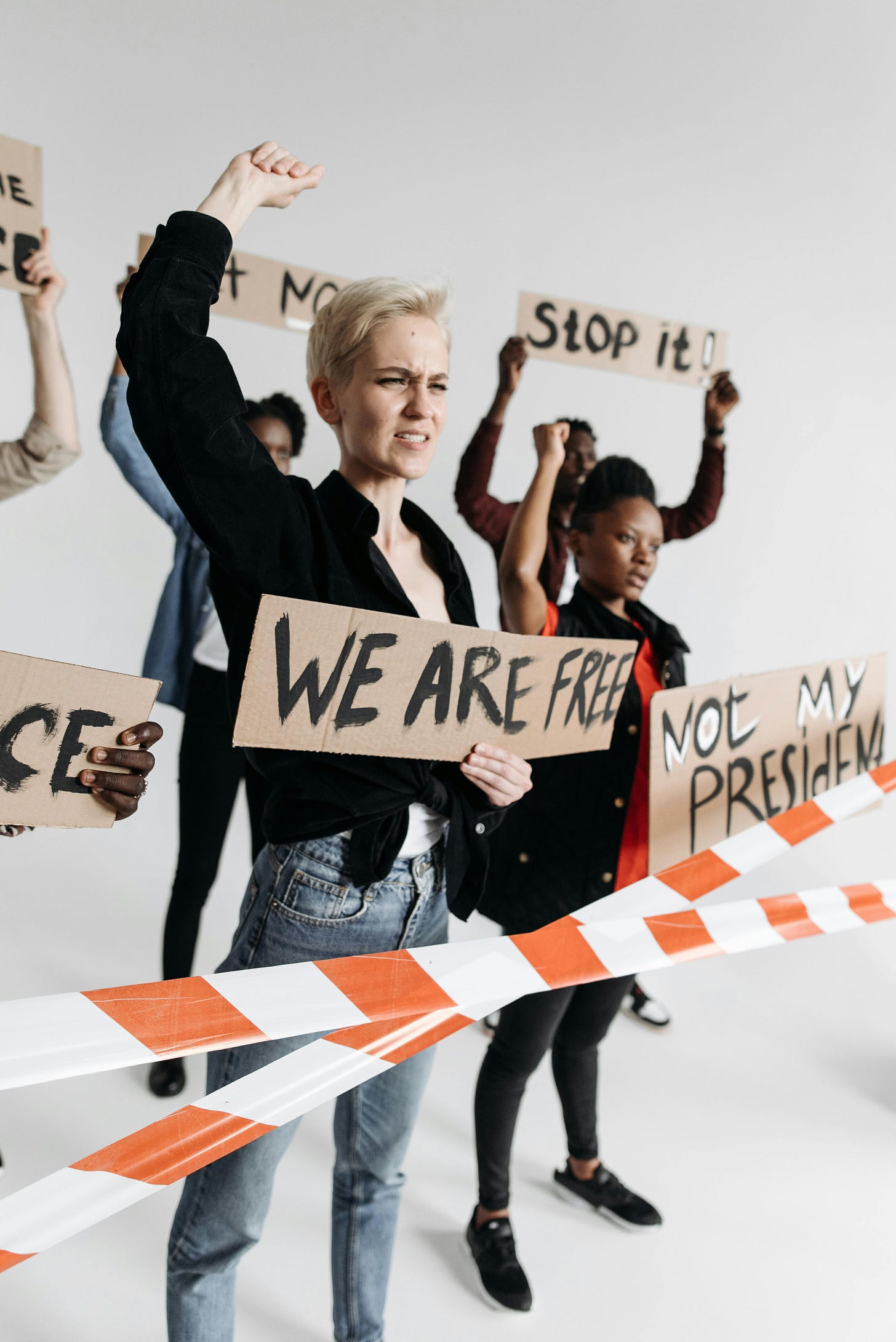By: Vix Burgett-Prunty
The 100 days post-2024 election period has seen a resurgence of public demonstrations, including the so-called "50501 protests", a reference to the recurring, symbolic rallies that follow predictable patterns: marches with pre-approved permits, carefully curated speeches, and social media hashtags that trend briefly before fading into obscurity. These protests, while well-intentioned, have proven largely ineffective in forcing structural change. Their failure lies in their adherence to respectability politics, a tactic that prioritizes palatability to white institutions over radical demands for justice. This approach has been heavily influenced by older generations (Boomers and Gen X) who, despite their historical ties to past movements, now often resist more confrontational tactics, fearing backlash from the very systems they claim to oppose.
Photo by Pavel Danilyuk
Why the 50501 Protests Don’t Work
Designed for Optics, Not Disruption. Many Progressive protests follow a sanitized formula: organizers obtain permits, coordinate with police, and stick to pre-approved routes that avoid major economic or political disruptions. This renders them easily ignored by those in power. Unlike the civil rights sit-ins of the 1960s or the Ferguson uprisings of 2014, which forced national attention through direct confrontation, today’s demonstrations often prioritize performative solidarity over tangible pressure. And let's not forget all the times that older folks have called the younger folks ignorant, stupid, and foolish. You can't build community that way.
Lack of Clear, Uncompromising Demands. The 50501 protests frequently center on vague slogans (“Justice for All,” “End Hate”) rather than specific, actionable policy goals (e.g., defunding police, reparations, abolishing the Electoral College). Without concrete objectives, politicians and corporations can pay lip service to protesters while maintaining the status quo.
Co-optation by Liberal Institutions. Corporate media, NGOs, and even political parties have learned to absorb and neutralize dissent by turning protests into PR opportunities. Politicians make symbolic gestures (kneeling in Kente cloth, issuing empty statements) while continuing to uphold policies that sustain white supremacy.
Generational Resistance to Radical Tactics. Many older activists, shaped by decades of assimilationist strategies, discourage tactics that might be deemed “too extreme” by mainstream white society. They argue for polite persistence, lobbying, voting, and “working within the system”, despite overwhelming evidence that these methods have failed marginalized communities for generations.
How Older Generations Uphold White Supremacy Through Activism
Boomers and Gen Xers, even those who consider themselves progressive, often unconsciously uphold white supremacy culture by:
Policing Tone. Criticizing younger activists for being “too angry” or “divisive,” reinforcing the racist demand that oppressed people protest in ways comfortable for their oppressors. In some cases, their flyers demanded more out of the protesters than it did out of the system or those in power.
Fetishizing Nonviolence. While paying homage to MLK, they ignore his later radical critiques of capitalism and militarism, reducing his legacy to passive, state-approved demonstrations.
Prioritizing Electoralism Over Movement Building. Convincing younger generations that change only happens through voting, despite both major parties consistently failing Black, Indigenous, and other marginalized voters.
Rejecting Economic Disruption. Opposing strikes, boycotts, or shutdowns that threaten corporate interests, effectively protecting capitalism, a system built on racial exploitation.
Beyond Performative Activism
For protests to be effective, they must:
Embrace Disruption. Shut down highways, occupy government buildings, and strike. Real change comes when power structures are forced to respond, not when activists politely ask for justice.
Center the Most Marginalized. Follow the lead of Black, Indigenous, and queer youth who have no interest in appeasing white moderates. After all, they've been showing us the blueprint. The organizers of many of the 50501 rallies are discarding that blueprint in favor of white supremacy.
Build Parallel Systems. Mutual aid, community defense networks, and independent political organizations must grow outside the control of the Democratic and Republican parties.
Reject Respectability. Stop watering down demands to make them “politically feasible.” Liberation has never been won by compromise.
The 50501 protests, as they currently exist, are a dead end. True resistance requires rejecting the fear-based conservatism of older activists and embracing the uncompromising urgency of a generation that has nothing left to lose.
None of what I'm saying is breaking news. If the organizers of the 50501 protest actually listened to Black women specifically these protest would have already been disruptive. It's clear that many of these organizers have done little to no unpacking of white supremacy from their life. It's even more clear that they are not reading anything that disagrees with their current worldview. They are using white supremacy as a crunch. To take down white supremacy you must discard the tools of white supremacy.
On the Ineffectiveness of Permitted, Non-Disruptive Protests
1. Tufekci, Z. (2017). Twitter and Tear Gas: The Power and Fragility of Networked Protest. Yale University Press.
2. Chenoweth, E. & Stephan, M. (2011). Why Civil Resistance Works. Columbia University Press.
3. The Atlantic: "The Institutionalization of Protest" (2018)
On Generational Divides in Activism
4. Taylor, K-Y. (2016). From #BlackLivesMatter to Black Liberation. Haymarket Books.
5. Ransby, B. (2018). Making All Black Lives Matter. University of California Press.
6. Pew Research: "Gen Z, Millennials Stand Out for Climate Change Activism" (2021)
On Respectability Politics and White Supremacy Culture
7. Cooper, B. (2018). Eloquent Rage: A Black Feminist Discovers Her Superpower. St. Martin’s Press.
8. Kendi, I.X. (2019). How to Be an Antiracist. Random House.
9. The Movement for Black Lives: "End the Money Bail System" (Policy Demand)
On the Co-optation of Protests
10. McKesson, D. (2022). On the Other Side of Freedom: The Case for Hope. Viking.
11. The Guardian: "How Corporations Co-Opted BLM" (2020)
Historical Precedents for Effective Disruption
12. Piven, F.F. & Cloward, R. (1979). Poor People’s Movements.* Vintage
13. SNCC Digital Gateway: "From Sit-Ins to Black Power"




